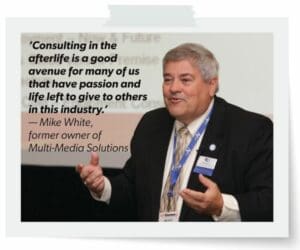On October 31, 2022, after 36 years, five months and five days of business ownership, Jeff Irvin, principal and chairman of La Mirada, Calif.-based Spinitar, decided to sell the business that his wife Barbara and he founded in May 1986. The couple, then in their mid-20s, navigated Presentation Products (dba Spinitar) into the world of systems integration.
The morning after the sale, Irvin recalls Spinitar’s then-CFO walking into his office, taking a seat across the table, looking him in the eye and asking him a simple question: “How are you doing?” Irvin started sobbing uncontrollably. “I was not prepared for the emotional impact of selling the business and walking away,” he acknowledges. “I went from black to white without passing through gray.”
Overnight, Irvin became a 1099 employee, which continued for two months before he left the company. “I have cried a lot more than I’ve laughed about all of this,” he says, adding, “not that I’m unhappy with the deal.” It’s just that managing the day-to-day operations of the business is what he was used to doing. “[When] you step out and can take a breath, it’s cool,” he notes. “But, at the same time, it’s very scary! It’s been tough.” Irvin recalls the industry friends…the relationships built over the years…the employees who were like his own extended family. Suddenly, all of that was gone from his usual day-to-day routine.
A Successful Marriage
Back in 1999, with the help of AV consultant Gary Kayye, Irvin was introduced to Jay Rogina. The two hit it off immediately, and, together, they grew Spinitar into a renowned $60 million design, build and after-sales-support integration firm specializing in corporate enterprises, government and education clients.
 As the demand for LCD projectors and flatpanels grew in the early 2000s, so did the business. With the help of Rogina’s expertise, they were able to turn the company from a transactional box-selling business to a consultative selling and integration service business. “We were blessed to be a part of that demand and that growth in that space,” Irvin reflects. “We lasted 24 years together. It was a successful marriage!”
As the demand for LCD projectors and flatpanels grew in the early 2000s, so did the business. With the help of Rogina’s expertise, they were able to turn the company from a transactional box-selling business to a consultative selling and integration service business. “We were blessed to be a part of that demand and that growth in that space,” Irvin reflects. “We lasted 24 years together. It was a successful marriage!”
Rogina, principal and CEO of Spinitar, recollects some naysaying from earlier in their careers. “[We were] told over and over by our contacts in the industry that we would fail,” he remembers. “But we [succeeded] with faith and a strong belief in our people.” Rogina makes a valuable point — namely, that integrators don’t actually make things. “We don’t manufacture anything,” he says. “We are special because of our people. We spent a lot of time over the years developing a process by which to hire people and bring them into the culture of our company.”
A Celebratory Culture
So, let’s take a look at that culture. Spinitar’s culture celebrated milestones and achievements, having a focus on taking care of employees to ensure company success. Rewards for service anniversaries included a watch at five years, a cruise at 10 years, personalized gifts at the 15-year anniversary, all the way up to a Viking Cruises voyage from Rome to Athens after 25 years of service. Employees of the quarter and of the year, as well as top-performing teams, were treated to trips to Mexico, Jamaica, the Bahamas, Hawaii, etc. “Our approach was always to first take care of our people, and they’ll take care of the company,” Irvin states. After all, both Rogina and he knew that Spinitar employees were the company’s most important asset.
The Decision to Sell
Once the duo approached their mid-60s, they realized that they needed to think more seriously about succession planning. They weren’t looking for a liquidity event, but they started having various conversations with other integration firms about merging, acquiring or being acquired.
“Those conversations were really fun,” Irvin recalls. “They were a nice break from the day to day. They made us think of the bigger picture. They’re exhilarating conversations, and a lot of people are having them in our industry.”
Rogina adds further detail to the story. “We were not looking at selling the business at the time we sold it,” he reveals. “We were in the process of buying another company. A couple of companies reached out to us, [but] we didn’t think it was a serious thing. Then, we went down the path and, the next thing you know, we had a letter of intent. It was a surreal feeling.”
 After doing due diligence and discovery to further evaluate the acquisition of another integration firm, Irvin and Rogina decided at the 11th hour that they were not going to follow through with the purchase. “Within 30 days of us backing away, [and] still interested in acquiring another business to help scale the company, we were approached by Solutionz,” Irvin relates. Very quickly — within 60 days, in fact — Spinitar went from being a buyer to being a seller.
After doing due diligence and discovery to further evaluate the acquisition of another integration firm, Irvin and Rogina decided at the 11th hour that they were not going to follow through with the purchase. “Within 30 days of us backing away, [and] still interested in acquiring another business to help scale the company, we were approached by Solutionz,” Irvin relates. Very quickly — within 60 days, in fact — Spinitar went from being a buyer to being a seller.
Solutionz, a Pacific Palisades, Calif.-based AV integrator, was an ideal choice for Spinitar. It resulted in an increased footprint for the company in the west, as well as no job losses for Spinitar’s 150 employees. In that way, it represented greater growth for everyone involved.
“There’s a lot of excitement, but a lot of reservation when it comes to selling a business,” Rogina explains. “Then, there’s the task of standing in front of employees and delivering the news. It was one of the hardest things to do.” After all, Spinitar employees had grown used to the Spinitar culture — and they loved it. So, naturally, there would be questions. “The biggest change in any transaction is the culture,” Rogina says. “I don’t think there’s any questions or anything that you can do to compare cultures until you’re in it. You don’t know what you don’t know until you experience it.”
Succession Planning
It’s worth asking whether the average business owner goes into business with some idea of a succession plan — for example, a liquidity event, an acquisition, a transition of the business to a family member, etc. Many go into business with goals in mind that revolve around creating value, building the company financially and getting the company to the level of performance expected. Outside the AV integration industry, many owners might be thinking about succession planning; in our industry, though, it seems like few do.
 “A lot of folks are so engaged — so busy fighting the daily fires of AV integration — they don’t go into the business that way,” Irvin shares. “They go into the business because they’re passionate about AV. They’re passionate about the industry. They love the work that they do. They oftentimes don’t go into it with the end zone in mind.” And he offers a candid admission: “I think we were guilty of that, too.” Irvin further reflects, “If I were to do anything differently, we should have approached it [earlier in our careers]. When I started the company, we were focused on how to make payroll!”
“A lot of folks are so engaged — so busy fighting the daily fires of AV integration — they don’t go into the business that way,” Irvin shares. “They go into the business because they’re passionate about AV. They’re passionate about the industry. They love the work that they do. They oftentimes don’t go into it with the end zone in mind.” And he offers a candid admission: “I think we were guilty of that, too.” Irvin further reflects, “If I were to do anything differently, we should have approached it [earlier in our careers]. When I started the company, we were focused on how to make payroll!”
Irvin offers additional reflections, saying, “When you’re a small business owner, it’s like driving down the freeway: Bugs are hitting your windshield; you’re trying to clean them all off with the wipers, but you can’t clean them off all the way. It just smears things, and you can’t see through.” When you sell your business, he says, you embark on a new chapter. “Suddenly,” Irvin continues, “there’s no bugs on the windshield. It’s kind of nice because you can see more clearly. But it’s a bit lonely — and a bit difficult — because you get to the point where you like to clean the bugs every day. You clean those bugs off the windshield every day and fight those daily fires. And that gives you a purpose in life.”
There’s one thing that Irvin certainly doesn’t miss: the day-to-day stress. He does, however, miss the people, and he misses waking up every day with a purpose. What Irvin is experiencing can be quite similar to the five stages of grief.
Tips for Priming Your Business for Sale
Irvin notes that AV integration is getting harder and client expectations are now much higher. To succeed in the competitive world of AV, it’s essential to continually improve the quality of your services, invest in your team and commit to ongoing education. It’s crucial to prioritize your organization’s value drivers — that is, the things your company does that truly add value and create additional stickiness with your customers.
And, although many AV business owners possess impressive technical skills, they might not necessarily excel in the realm of business strategy and management. It’s common to encounter integration entrepreneurs who struggle with the financial and operational aspects of running their business. Increasingly, industry observers are noting the criticality of striking a balance between technical prowess and business acumen to thrive in the AV industry.
So, here are some words of advice: Don’t be afraid to seek outside assistance. Be more strategic and cultivate a business that has immense value at the end of the day; doing so will afford the owner the ability to exit with a phenomenal legacy. A big value driver for Spinitar was its ongoing customer support, which extended long after the initial project was done. A remote helpdesk, as well as remote troubleshooting, improved client satisfaction and retention, as well.
Life After Business Ownership
Mike White, the former owner of Multi-Media Solutions, says that, in actuality, his business owned him. While on a 14-day cruise in the Mediterranean with his wife, he found himself sneaking away to the top deck with his iPad to answer emails. White sold Multi-Media Solutions after more than 25 years of ownership. He admits, though, that it wasn’t necessarily the grand exit that he’d hoped for. “Eastern Airlines, Bed Bath & Beyond and other large organizations, they were great organizations for years,” White reflects. “And it didn’t end exactly as they planned.”
 White had a family-oriented succession plan in mind about 10 years into business ownership. His oldest son was interested in the business and learned the ropes. White included him in the toughest discussions, including the firing of a very skilled employee. He wanted his son to get a taste of the good, the bad and the ugly aspects of running a business. Although him taking the reins of the family business didn’t work out exactly as planned, White’s son works for another integration firm today and loves what he does. Speaking with pride, White says, “I’m so honored that he still calls or sends me a proposal and says, ‘Dad, could you take a look at this and see what holes there are?’”
White had a family-oriented succession plan in mind about 10 years into business ownership. His oldest son was interested in the business and learned the ropes. White included him in the toughest discussions, including the firing of a very skilled employee. He wanted his son to get a taste of the good, the bad and the ugly aspects of running a business. Although him taking the reins of the family business didn’t work out exactly as planned, White’s son works for another integration firm today and loves what he does. Speaking with pride, White says, “I’m so honored that he still calls or sends me a proposal and says, ‘Dad, could you take a look at this and see what holes there are?’”
For White, life completely changed the day after he sold his business. The desk that he previously owned someone else now owned. Instead of making key business decisions on his own, he had to go check with someone else. After working part time for the acquired company for a few months, White decided to leave.
“I went to three of my good friends who were running businesses locally and sat down with them,” he recollects. “I said, ‘You’ve known me for 15 or 20 years. What should I do now?’ One looked at me and said, ‘Mike, you’re a damn maven.’” And that sparked White to start his own digital-signage consultancy: AV Maven.
White admits he’s genuinely enjoying being a consultant these days. “Consulting in the afterlife is a good avenue for those of us who are not done when we sell our business,” he declares. “There’s many of us that have passion and life left to give to others in this industry.”
For White, former business owners have a tall order ahead of them after they sell their business. “They need to figure out how to be happy,” he reflects. “It’s more than money afterward. They must figure out where they’re going to funnel that passion.” He continues, “The day that they received the check or the day that they signed that note, their passion doesn’t go away with it. Their passions continue.”
White’s primary advice is simple: Don’t just sit on the bench; instead, give back to the industry! As he puts it, “I believe those who [think they] want to play golf in retirement, there’s an element in them as a business owner that says, ‘I can teach others a few things about the things that didn’t go well in my life. I don’t want that to happen to them.’”
An Exit Strategy
 Are you preparing to sell your business? If so, Rogina underscores the importance of making sure you’re ready. “You might take a 30-day transition, and [then] you’re out,” he says. “You need to move on because it’s very hard to be an employee when you’ve been the owner.” Rogina continues, “I think ‘ready to sell today’ means, ‘I’m ready to sell, [and] I’m going to move on.’ The transition from owner to employee can feel like you’ve sold your house and the buyers are rearranging furniture while you are still living there. Knowing that it’s going to happen and watching it happen are two different things.”
Are you preparing to sell your business? If so, Rogina underscores the importance of making sure you’re ready. “You might take a 30-day transition, and [then] you’re out,” he says. “You need to move on because it’s very hard to be an employee when you’ve been the owner.” Rogina continues, “I think ‘ready to sell today’ means, ‘I’m ready to sell, [and] I’m going to move on.’ The transition from owner to employee can feel like you’ve sold your house and the buyers are rearranging furniture while you are still living there. Knowing that it’s going to happen and watching it happen are two different things.”
Rogina announced his official retirement on LinkedIn. In a reflective mood, he says, “In the days leading up to retirement, the comments and stories that people shared with me about the past 24-plus years were a huge highlight for me.” And those comments and stories testify to how Irvin and he ran their business.
“At the end of the day, I did something right,” Rogina says. “There’s a legacy there — memories that people will keep in their minds and hearts forever.” Those reminiscences helped him get through the transition from business ownership. “I’m still passionate about business,” he states. “I still love the industry. There’s nothing like the people and the relationships in the audiovisual world.”
Rogina closes on a positive note, channeling White’s words of wisdom: “My hope, moving forward, is to share my experience and help educate others and achieve similar success in business and/or in the power of a positive culture.”



